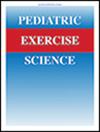Physical Activity Predicts Better Lung Function in Children and Adolescents.
IF 1.3
4区 医学
Q3 PEDIATRICS
引用次数: 0
Abstract
PURPOSE To investigate (1) whether physical activity is associated with lung function in children and adolescents, (2) whether this association is modified by the subjects' weight status, and (3) whether this association is mediated by the body mass index. METHODS This is a cross-sectional study including 460 participants aged 7-17 years, randomly selected from 13 public schools in southern Brazil. Collected data included anthropometric measures, physical activity, screen time, and spirometric measures expressed as percent predicted values. Data were analyzed using multiple linear regression and 2-way analysis of variance. RESULTS There were positive associations between physical activity and forced vital capacity (β = 3.897, P = .001) and forced expiratory volume in the first second (β = 2.931, P = .021). The effect modification by weight status was not statistically significant (forced vital capacity: Pinteraction = .296 and forced expiratory volume in the first second: Pinteraction = .057). Body mass index did not mediate the association between physical activity and spirometric outcomes (P > .05). CONCLUSION Regular physical activity was associated with higher forced vital capacity and forced expiratory volume in the first second in children and adolescents. The observed associations were not modified by weight status nor mediated by body mass index. Our results reinforce the importance of regular physical activity for the development of lung function during childhood and adolescence.体育锻炼可提高儿童和青少年的肺功能。
目的调查:(1) 体力活动是否与儿童和青少年的肺功能有关;(2) 受试者的体重状况是否会改变这种关联;(3) 体重指数是否会调节这种关联。方法这是一项横断面研究,包括从巴西南部 13 所公立学校随机挑选的 460 名 7-17 岁的参与者。收集的数据包括人体测量、体育活动、屏幕时间和以预测值百分比表示的肺活量测量。结果体力活动与用力肺活量(β = 3.897,P = .001)和第一秒用力呼气量(β = 2.931,P = .021)呈正相关。体重状况的影响修正在统计学上并不显著(用力肺活量:Pinteraction = 0.296,第一秒用力呼气量:P = 0.001):Pinteraction = .296 和第一秒用力呼气量:Pinteraction = .057)。身体质量指数对体育锻炼与肺活量测量结果之间的关联没有中介作用(P > .05)。观察到的关联既不受体重状况的影响,也不受体重指数的介导。我们的研究结果进一步说明了经常进行体育锻炼对儿童和青少年肺功能发育的重要性。
本文章由计算机程序翻译,如有差异,请以英文原文为准。
求助全文
约1分钟内获得全文
求助全文
来源期刊

Pediatric Exercise Science
医学-生理学
CiteScore
2.80
自引率
0.00%
发文量
33
审稿时长
>12 weeks
期刊介绍:
Pediatric Exercise Science is a journal committed to enriching the scientific knowledge of exercise during childhood and adolescence. To this end it publishes information that contributes to an understanding of (a) the unique aspects of the physiologic, physical, biochemical, and psychologic responses of children to exercise, (b) the role of exercise in the treatment of pediatric chronic diseases, (c) the importance of physical activity in the prevention of illness and preservation of wellness, and (d) the means by which participation in sports may be made safer and more enjoyable for children and youth. Consideration will be given for publication of work by various methodologies consistent with the scientific approach.
Besides original research, the journal includes review articles, abstracts from other journals, book reviews, and editorial comments. Pediatric Exercise Science encourages the expression of conflicting opinions regarding children and exercise by providing a forum for alternative viewpoints. At the same time it serves as a means of accumulating a base of research information that will allow application of experimental data to clinical practice. The scientific disciplines contributing to this body of knowledge are diverse. Therefore it is the purpose of this journal to provide a common focus for disseminating advances in the science of exercise during childhood. In doing so, the journal allows the opportunity for cross-fertilization of ideas between disciplines that will potentiate the growth of knowledge in this field. Pediatric Exercise Science seeks to stimulate new ideas regarding exercise in children and to increase the awareness of scientists, health care providers, and physical educators of the importance of exercise during childhood.
 求助内容:
求助内容: 应助结果提醒方式:
应助结果提醒方式:


